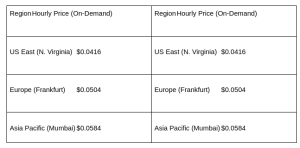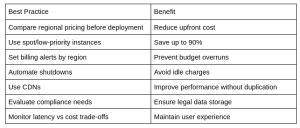Cloud Cost Optimization Based on Region: A Comprehensive Guide
As we accelerate toward digital transformation, cloud computing is becoming a backbone for organizations looking to achieve scale, flexibility, and efficiency. With this rapid adoption of cloud services also comes the topic of cost management and optimization.
Cost management is a key topic for business today, but one of the most powerful means of possible cost optimization is really simple and frequently overlooked. Cost optimization may come from selecting the region associated with the cloud service. In addition to cost, the cloud region influences performance, compliance, user experience, and value.
In this blog, we will examine the topic of cost optimization based on cloud region in detail, including what it is, why it matters, how pricing varies by region, and practical ideas to lower cloud expenses by leveraging regional choices.
Understanding Cloud Regions
What does cloud region mean?
A cloud region is a particular geographic area in which a cloud provider (AWS, Azure, or Google Cloud) has data centers. A region usually has several availability zones (AZ) for fault tolerance and high availability.
For example,
- AWS: There are regions such as us-east-1 (N. Virginia), eu-west-1 (Ireland), ap-south-1 (Mumbai)
- Azure: There are regions such as the East US, North Europe, and Southeast Asia.
- Google Cloud: There are regions such as us-central1, europe-west2, and asia-southeast1.
Each region will have its own pricing, available services, and latency.
How Does Cloud Region Impact Pricing?
Overall, cloud pricing tends to not be standardized worldwide. Here are some reasons why:
1. Costs of running the data center
Running a data center in one country could end up costing more overall (example: labor, taxes and tariffs, power and cooling costs, and real estate prices)
2. Demand vs. Capacity
High-demand regions may reflect premium pricing because of scarcity or strategic placement, whereas lack-of-demand regions may take a discounting pricing approach and/or give discounts to attract customers in the first place.
3. Regulatory compliance
Some regions may be expensive because of compliance driven standards (ex. GDPR, HIPAA, local laws on data residency, etc.)
4. Currency (exchange rate)
Cloud providers can set pricing based on currency fluctuations in certain local markets. Exchange rates lead to regional pricing differentials, which can have an even larger impact for customers if they have a billing inflation in local currency.
Pricing Differentials: Actual Examples
Let’s compare the cost of a basic virtual machine (VM) on AWS and Azure across three different regions.
AWS EC2 t3.medium (2 vCPU, 4 GB RAM)

Observation: Hosting the same EC2 instance in Mumbai is ~40% more expensive than in N. Virginia.
Azure B2s VM (2 vCPU, 4 GB RAM)

Once again, we see a substantial increase in cost with choosing a region.
Key Factors to Consider When Selecting a Region to Optimize Cost
Before rushing to the cheapest region, consider:
1. Latency and Performance
Cheaper regions may lead to higher latencies. Hosting in a distant region leads to slow response times for end-users.
Tip: Run a latency test using CloudPing (AWS), Azure Latency Test, or GCP Network Performance Monitor.
2. Data Transfer Costs
It can get expensive to transfer data, especially inter-region data transfer. Even if computers are cheaper in a different region, you may be spending as much as you save on data egress (in and out).
Example: AWS is ~$0.02/GB for inter-region data transfer, and your app has 10 TB/month of transfers, $200 just in data transfer costs.
3. Service Availability
When you choose a region, different services and instance types may not be available. Some services may be in preview or not available at all.
4. Compliance/Data Residency
Some businesses have compliance obligations to store data in a country or region based on legislative reasons, such as, GDPR, HIPAA, etc.
5. Disaster Recovery (DR) Requirements
If you are creating a secondary region for DR reasons, go with a region that is distant but has the best pricing.
Strategies to Help Manage Your Cloud Costs by Region
1. Compare Before You Provision Your Resources by region
Check your cloud provider’s pricing calculator before provisioning resources.
- AWS Pricing Calculator: https://calculator.aws.amazon.com/
- Azure Pricing Calculator: https://azure.microsoft.com/en-us/pricing/calculator/
- GCP Pricing Calculator: https://cloud.google.com/products/calculator
You can compare the costs of the same resource (i.e., VM, storage, database, etc.) across regions.
2. Use Spot/Preemptible Instances in cheaper regions
Regions with lower demand for spot-priced resources will usually offer lower prices.
For example, the AWS spot price for us-east-2 may be 70%-80% less compared to standard on-demand prices available in eu-west-2.
3. Scheduling of resources
If your workload is more non-critical or more batch jobs (i.e., you are training ML models or simply rendering), consider timing your workloads that can be run in your cheaper region during “off hours” for your users.
Tip: you can automate this process with AWS Lambda, Azure Automation, or GCP Cloud Scheduler to shut down resources that are not in use
4. Multi-Region Strategy
Split your workloads in two:
- Frontend in regions that are closer to end users
- Backend or batch processed state in regions that are cheaper
This hybrid model gives you value and performance.
5. Data Storage Tiering by Region
Store commonly accessed data in high-performing (and closer) regions. Archive or back up data in a cheaper, farther region.
Example: Use AWS S3 Glacier Deep Archive in us-west-2 rather than eu-central-1 for your long-term backup.
6. Monitor, and Analyze Frequently
Create cost alerts and analyze your billing data by using
- AWS Cost Explorer
- Azure Cost Management + Billing
- GCP Cost table reports
Filter by region to determine your largest spending so you can adjust as necessary.
7. Use CDNs Instead of Replication across Regions
Instead of replicating your app in multiple regions, use a Content Delivery Network (CDN) to cache the content closer to your users.
Example: AWS CloudFront, Azure Front Door, Cloudflare.
Case Study: Regional Cost Optimization with Action
Company: SaaS Startup “DataSavvy”
Problem: Running their application entirely in AWS Frankfurt (eu-central-1), which resulted in monthly costs of over $5,000 a month.
Solution:
- We moved compute heavy workloads (batch processing) to us-east-1
- We maintained the customer-facing frontend in eu-central-1 for performance.
- We moved backups to us-west-2 Glacier Deep Archive
- We used CloudFront to deliver static content to end users worldwide.
Result: A savings of approximately 30%, bringing their monthly bill down to approximately $3,500 a month while still providing their users with the experience they expect.
Things to Consider When Optimizing by Region
❌ Only Choosing the Cheapest
Choosing a region based only on the cheapest cost without consideration for performance or terms of service could potentially have negative impacts on your app and your business.
❌ Unforeseen Costs
Cheap computers don’t mean cheap storage, cheap networking, or even just more expensive services. Always consider total cost of ownership (TCO).
❌ No Governance
If you don’t track resources by region and their intended purposes, cloud sprawl and unexpected billing will always be on the horizon.
Best Practices Checklist

Conclusion
Cloud cost optimization isn’t about taking your bill and reducing it; it’s about smart resource planning. Regional differences can have a major impact on your cloud spend. If done smartly, regional selection can save your organization $$$$ without loss of performance or rights/terms of service limitations.
While cloud use continues to increase, it is important for organizations to progressively adopt a region-aware strategy for the cloud. Using calculators, performance testing, automation, and monitoring can dramatically increase control while making your cloud services cost-effective in regard to your regional selections.
How long ago did you look at region costs for the cloud?
